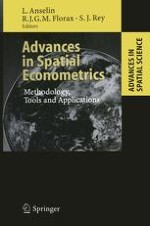2004 | OriginalPaper | Buchkapitel
The Performance of Diagnostic Tests for Spatial Dependence in Linear Regression Models: A Meta-Analysis of Simulation Studies
verfasst von : Raymond J. G. M. Florax, Thomas de Graaff
Erschienen in: Advances in Spatial Econometrics
Verlag: Springer Berlin Heidelberg
Enthalten in: Professional Book Archive
Aktivieren Sie unsere intelligente Suche, um passende Fachinhalte oder Patente zu finden.
Wählen Sie Textabschnitte aus um mit Künstlicher Intelligenz passenden Patente zu finden. powered by
Markieren Sie Textabschnitte, um KI-gestützt weitere passende Inhalte zu finden. powered by
One of the reasons for A.D. Cliff and J.K. Ord’s 1973 book “Spatial Autocorrelation” achieving the status of a seminal work on spatial statistics and econometrics lies in their careful and lucid treatment of the autocorrelation problem in spatial data series. Cliff and Ord present test statistics for univariate spatial series of categorical (nominal and ordinal) and continuous (interval or ratio scale) data. They extend the use of autocorrelation statistics, specifically Moran’s I (Moran, 1948), to the analysis of regression residuals (see also Cliff and Ord, 1972). The detection of spatial autocorrelation among regression residuals implies either a nonlinear relationship between the dependent and independent variables, the omission of one or more spatially correlated regressors, or the appropriateness of an autoregressive error structure. Ignoring the presence of spatial autocorrelation among the population errors causes ordinary least squares (OLS) to be a biased variance estimator and an inefficient regression coefficient estimator. Anselin (1988b) shows that erroneously omitting the spatially lagged dependent variable from the set of explanatory variables causes the OLS estimator to be biased and inconsistent. Cliff and Ord (1981, p. 197) therefore urge the applied researcher to always apply “some check for autocorrelation,” and take remedial action when necessary.
